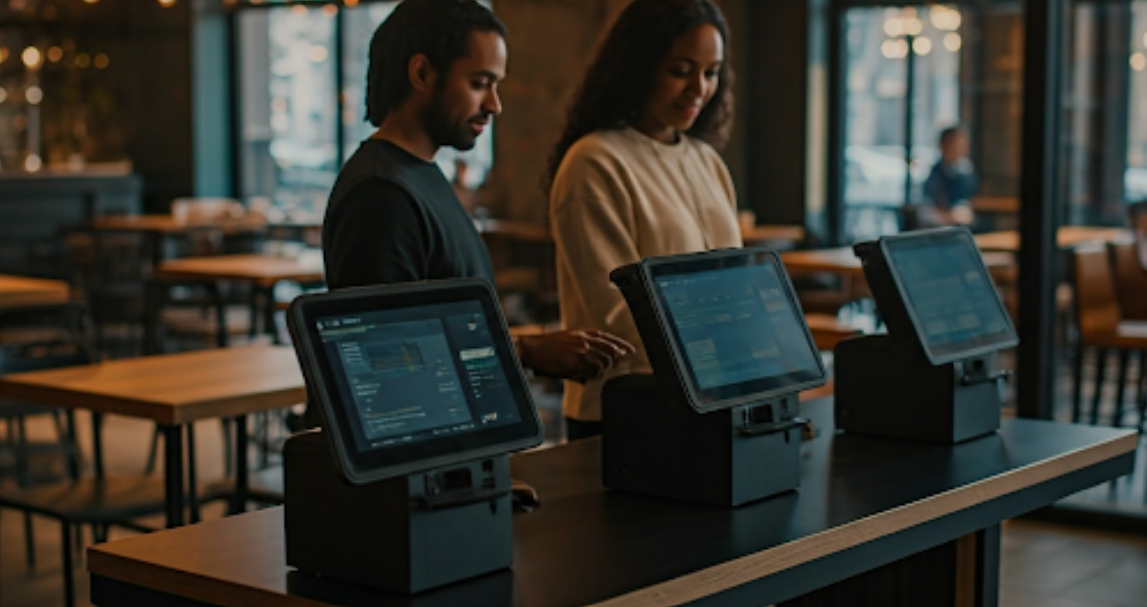
Key Highlights
- Integration of CRM systems with self-service payments redefines operational efficiency in the restaurant industry.
- Restaurant CRMs centralise customer data to deliver personalised services and targeted marketing campaigns.
- Self-service payment solutions enhance customer satisfaction by offering faster and safer transactions.
- The merge of CRM and automation reduces wait times, improves table turnover, and lowers labour costs.
- Actionable insights from data analytics enable tailored marketing strategies, boosting profitability and repeat business.
Introduction
In the busy restaurant industry, handling customer relationships well is key to success. Restaurant CRMs, or Customer Relationship Management systems, are important tools. They help improve guest interactions, keep customer data safe, and make operations smoother. When paired with modern self-service payment options, these systems are changing how restaurants work. By using a special CRM platform, businesses can boost customer satisfaction. This helps them meet high expectations and create memorable dining experiences while improving both operations and finances.
Revolutionising Checkout: The Merge of CRM and Self-Service Payments in Restaurants
The use of CRM systems and self-service payment tools in the restaurant industry is helping to combine convenience with personalisation. CRM for restaurants is especially effective at gathering guest data and preferences, making it easier for owners to create unique experiences tailored to each customer.
Self-service payments work well with CRM platforms. They give customers the power to manage their transactions, cutting down wait times and helping tables turn over faster. This smooth connection improves both how the restaurant runs and the dining experience by focusing on speed, safety, and personalisation.
1. Streamlining Order Processes with Integrated CRM Systems
A strong restaurant CRM system makes it easier for restaurants to handle orders and manage customer interactions. By using integration capabilities, these systems connect smoothly with POS platforms, online ordering sites, and loyalty programs.
Watching order history through these systems gives useful insights into what guests like. This helps restaurants serve their customers better. For example, if a diner often orders vegetarian dishes, restaurants can suggest special menu items or run targeted marketing campaigns to boost engagement and repeat business.
Keeping customer data in one profile helps restaurant team members provide personalised service. They can customise dining preferences or offer special deals at the right time. CRM platforms make processes easier so restaurants can focus on forming good relationships. From bookings to takeaway orders, CRM integration makes sure every interaction improves the guest experience.
2. Enhancing Customer Experience through Self-Service Solutions
Self-service payments are changing how customers feel about dining. They give customers more control over their experience. With these systems, patrons can order and pay using digital platforms. This removes the need for traditional interactions and speeds up the service.
A big plus is how easy online ordering is. Guests can place accurate orders right from their mobile devices at any time and place. Restaurant CRM systems make this even better by tracking customer behavior and tailoring what they offer to meet exact needs.
This increase in efficiency lifts satisfaction rates and makes work easier for employees. By cutting down on order mistakes and speeding up transactions, self-service payment options help build good customer relationships and encourage repeat visits. When restaurants use CRM alongside these technologies, they can give better experiences to modern diners, which helps create strong loyalty.
3. Leveraging Data Analytics for Personalised Marketing
Using data analytics helps restaurants create better marketing plans based on useful insights. CRM systems give detailed customer data that is key for making effective campaigns aimed at guest behavior.
- Track what customers like, such as when they eat and what they order, to make marketing campaigns that connect.
- Use useful insights to find important customers and offer them special loyalty rewards.
- Apply analytics to check how well campaigns do, making sure they keep improving.
By connecting analytics with restaurant CRM systems, restaurants can move from regular promotions to focused campaigns that meet customer needs. This ability to follow trends and performance facts helps owners make smarter choices and use their resources well. With targeted email marketing, restaurants can keep in touch with their guests. This improves engagement and builds a loyal customer base for ongoing growth.
4. Improving Operational Efficiency with Automated Payment Systems
Automation is changing how restaurants manage payment processes. By using CRM systems with automatic self-service payments, restaurants can be more efficient.
These automatic solutions cut down on manual work, which helps to reduce errors in transactions. By connecting with advanced POS systems, data flows smoothly. This allows staff to focus more on interacting with diners instead of handling payments. This setup helps prevent delays during busy times, providing a great guest experience from beginning to end.
With automation, restaurant owners can improve table turnover rates and make workflows easier. These systems also increase accuracy, which builds trust between diners and restaurant owners. When automated payment platforms and CRM systems work together, they improve productivity and give flexibility to meet changing customer needs.
5. Building Stronger Customer Relationships with Loyalty Programs
Loyalty programs are very important for managing customer relationships in restaurants. With CRM platforms, restaurants can create great loyalty rewards that help bring back customers again and again.
| Loyalty Program Benefits | Impact on Restaurant Relationships |
| Points Accumulation | Encourages repeat visits |
| Personalised Rewards | Increases customer satisfaction |
| Exclusive Offers | Builds a loyal customer base |
CRM systems help restaurants understand guest behavior and dining history. This helps them create loyalty plans that feel customised. Restaurants can offer discounts or special menus, making them stand out. By using marketing automation and guest data, loyalty programs help build strong relationships. This turns occasional diners into faithful regulars.
The Impact of Self-Service Payments on Restaurant Operations
Self-service payments are changing how restaurants work by making them more efficient and safe. These systems help shorten wait times at checkout. This means faster table turnover, so customers can have smoother dining experiences.
Also, the contactless feature of these payments improves hygiene in the restaurant industry. When used with CRM platforms, self-service systems gather useful data. This data not only helps improve how things run but also allows for personalised customer service. This way, owners can create lasting relationships with their customers and boost profitability.
Reducing Wait Times and Increasing Table Turnover
Good table management is important for making more money, and self-service payments help speed up checkout. When wait times go down, restaurants can take care of more guests without losing quality.
With CRM, restaurants can study guest behavior, like how long customers stay, to improve seating. They can use information about busy times or favourite tables to work better.
In the end, automating payment tasks reduces downtime and improves the customer experience. These tools help restaurants meet their needs while giving great service, which keeps customers coming back and increases revenue.
Facilitating Contactless Transactions to Boost Safety
Contactless payments are very important in today’s restaurant industry. They help keep customers safe and make paying more convenient. Diners can use mobile apps or kiosks to pay, which ensures a clean experience for those who are tech-friendly.
CRM systems boost these services by remembering guest preferences and how they like to pay. For instance, loyalty programs linked to contactless payments let repeat diners check out quicker and enjoy special rewards.
This focus on safety helps restaurants build trust. Diners are more likely to visit places that offer new solutions. In the end, using CRM with contactless payments helps improve industry standards and supports customer satisfaction goals.
Lowering Labour Costs by Automating Routine Tasks
Automation makes everyday tasks easier in restaurants. This greatly lowers labour costs. Self-service payment systems remove the need for extra staff at counters. This lets fewer workers manage several roles effectively.
Adding CRM helps cut costs even more. It automates things like reservations and updating guest profiles. With this simple method, there are fewer mistakes. Staff can also spend more time providing great service.
In the end, using automation allows restaurants to use their resources better. It builds efficient workflows and lowers operational costs while making guests happier.
Minimising Human Error in Billing and Payments
Automated payment systems help reduce mistakes by people and ensure that all bills are correct. Integrated CRM platforms help by checking guest profiles and payment preferences, making sure everything runs smoothly. With payment providers like Stripe.
These systems let restaurant owners be clear about transactions, which builds trust with customers. For example, CRM-based automated payments can quickly flag any issues, protecting both diners and restaurants from regular errors.
Combining automation and CRM solutions changes how payments are handled. It creates an easy process where billing errors are gone, and there is more confidence in the service.
Enabling Real-Time Performance Monitoring and Insights
Real-time insights are very important for today’s restaurant operations. With CRM systems, businesses can keep an eye on key details like busy hours and sales patterns.
Data about what customers like helps restaurants improve their menus. This keeps guests coming back. CRM tools, along with self-service systems, record every contact. This means data can turn into numbers that help in decision-making.
This technology helps owners make smart changes to menu styles or seating plans. This leads to better efficiency and more customer satisfaction. Real-time monitoring helps with daily management and can boost profits over time.
Conclusion
Combining CRM systems with self-service payment solutions is changing the restaurant industry. It improves how restaurants work and makes the customer experience better. By simplifying order processes and using data analytics, restaurants can give personalised service that makes customers return. Reduced wait times and lower labor costs allow restaurant owners to focus on what matters most: providing excellent dining experiences. As we head into a tech-driven future, using these innovations will be important for restaurants that want to do well in a competitive market. If you want to stay ahead and improve your restaurant operations, look into how blending CRM with self-service payments can boost your business.
Frequently Asked Questions
How Does CRM Integration Affect Customer Service in Restaurants?
CRM integration helps restaurants give personal service to customers. It does this by keeping track of guest preferences and order history in one profile. This gives team members useful insights. As a result, communication becomes easier. Offerings can be tailored to each guest, leading to great experiences at the right time.
Does a CRM System Help with Marketing Efforts?
Yes. CRM systems allow restaurants to segment their customers and send targeted marketing campaigns based on behavior and preferences. This means promotions reach the right people at the right time—leading to better engagement, increased reservations, and higher return on investment.
Is CRM Integration Difficult for Restaurant Teams to Use?
Not at all. Most modern CRM platforms are designed with user-friendly dashboards and integrate seamlessly with existing restaurant systems. With basic training, staff can easily access guest profiles, update notes, and use the data to enhance service without slowing down operations.



